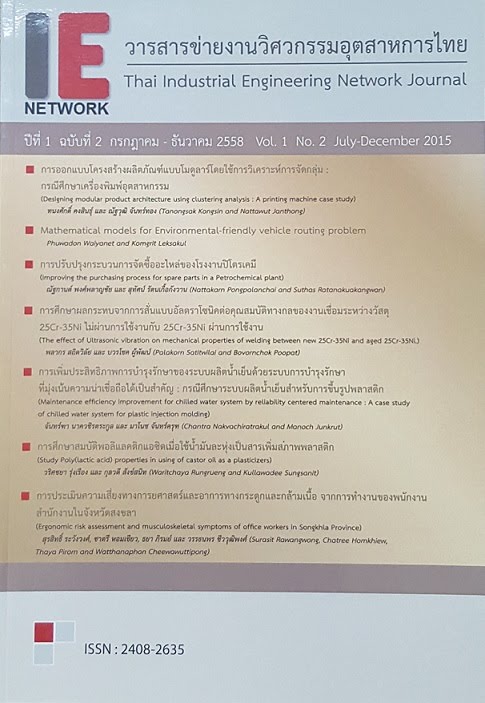The Effect of Ultrasonic Vibration on Mechanical Properties of Welding Between New 25Cr-35Ni and Aged 25Cr-35Ni.
Main Article Content
Abstract
Welding repair of heat resistant steels has sometimes involved in joining of new materials and in-service materials which might be degraded from its long high temperature service. Ultrasonic vibration applied to weld metal during welding has been known that it can help improve mechanical properties of certain type of weld metal. However, most of the studies focused on welding of new materials. The objective of this work is to study the effect of ultrasonic vibration on mechanical properties of welding between new 25Cr-35Ni and aged 25Cr-35Ni heat resistant steel. Gas Tungsten Arc Welding (GTAW) with matching filler metal (25Cr-35Ni) was used in this study. Ultrasonic vibration with a frequency of 20 kHz was applied to the samples during welding pool solidification. Tensile strength, micro hardness, and microstructure analysis of weld with and without assisting ultrasonic vibration were compared. The results showed that ultrasonic vibration applied during solidification promoted grain refinement but mechanical properties of weld with assisting ultrasonic vibration could not be improved due to redistribution of rounded chromium carbide precipitation in weld metal.
Article Details
บทความ ข้อมูล เนื้อหา รูปภาพ ฯลฯ ที่ได้รับการตีพิมพ์ในวารสารฯ ถือเป็นลิขสิทธิ์ของวารสารฯ หากบุคคลหรือหน่วยงานใดต้องการนำทั้งหมดหรือส่วนหนึ่งส่วนใดไปเผยแพร่ต่อหรือเพื่อกระทำการใดๆ จะได้รับอนุญาต แต่ห้ามนำไปใช้เพื่่อประโยชน์ทางธุรกิจ และห้ามดัดแปลง
References
[2] Y. Cui, C.L. Xu and Q. Hua. Effect of Ultrasonic Vibration on Unmixed Zone Formation, Scripta Materialia 55(2006) 975-978.
[3] Titinan Methong, Bovornchok Poopat, The effect of Ultrasonic Vibration on Properties of Weld Metal, Key Engineering Materials Vol.545(2013) pp 177-181.
[4] Michael J. Troughton, 2008, Handbook of Plastics Joining, 2nd ed., William Andrew Inc., Norwich, New York, pp. 23-30.
[5] API 571 Damage Mechanisms Affecting Fixed Equipment in the Refining Industry. December 2003.
[6] R. Dehmolaei, M. Shamanian, A. Kermanpur, Microstructure Characterization of Dissimilar Welds Between Alloy 800 and HP Heat-Resistant Steel, Material’s Characterization 59(2008) 1447-1454.
[7] W. A. Baeslack, J.C. Lippold and W.F. Savage, Unmixed Zone Formation in Austenitic Stainless Steel Weldments, Welding Research Supplement(1979) 168s-176s.
[8] Qingmei Liu, Qijie Zhai, Feipeng Qi, Yong Zhang, Effects of Power Ultrasonic Treatment on Microstructure and Mechanical Properties of T10 Steel, Material Letters(2007) 2422-2425.
[9] Saeed Reza Allahkaram, Sadegh Borjali, Hamed Khosravi, Investigation of Weldability and Property Changes of High Pressure Heat-Resistant Cast Stainless Steel Tubes Used in Pyrolysis Furnaces After a Five-Year Service, Material and Design33(2012) 476-484.
[10] J.N.Dupont, S. W. Banovic and A. R. Marder, Microstructural Evolution and Weldability of Dissimilar Welds Between a Super Austenitic Stainless Steel and Nickel-Based Alloys, Welding Journal(2003) 125s-135s.
[11] G.I. Eskin, Ultrasonic Treatment of Light Alloy Melts, Gordon and Breach, London, 1998, p.18.
[12] H.M. Tawancy, Degradation of Mechanical Strength of Pyrolysis Furnace Tubes by High-Temperature Carburization in a Petrochemical Plant, Engineering Failure Analysis 16(2009) 2171-2178.


